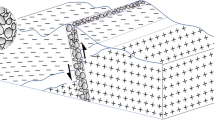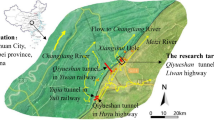Abstract
Water inrush due to rock mass progressive failure in karst tunnels is one of the disasters in tunnel construction. The practical measures to ensure the safety of tunnel construction are to clarify the mechanism of water inrush and reserve the safety thickness. In this paper, the geomechanical model test and numerical simulation were carried out based on the Xiema Tunnel in Chongqing, China. The results of the displacement and hydraulic pressure of the monitoring points in the physical and numerical models were analyzed. In view of the reserved safety thickness between the tunnel face and the water-filled karst cave, the orthogonal numerical simulation tests were designed considering the influence of the tunnel diameter, the cave diameter, the cave water pressure, and the surrounding rock grade. The influence laws and response sensitivity of each factor on the safety thickness were obtained. According to the numerical simulation results and the multiple linear regression method, the formula of safety thickness was derived. Finally, some measures and suggestions for preventing and controlling water inrush disasters were obtained.










Similar content being viewed by others
Data Availability
The datasets generated during and/or analyzed during the current study are available from the corresponding author on reasonable request.
Code Availability
All code generated or used during the study are proprietary or confidential in nature and may only be provided with restrictions.
References
Ariani F, Baldasseroni A, Muller A, Biffino M, Matteucci A (2017) Reduction of excavation face collapse risk in tunneling. Med Lav 108:446–454
Chen ZY, Zhang YP, Li JB, Li X, Jing LJ (2021) Diagnosing tunnel collapse sections based on TBM tunneling big data and deep learning: a case study on the Yinsong Project, China. Tunn Undergr Sp Tech 108:103700
Chen JX, Xu ZL, Luo YB, Song JK, Liu WW, Dong FF (2020) Application of the upper-bench CD method in super large-span and shallow tunnel: a case study of Letuan Tunnel. Adv Civ Eng 2020:1–16
Gan KR, Yang Y, Li JS (2007) Analysis on karst water inflow mechanism and determination of thickness of safe rock walls: case study on a tunnel. Tunn Constr 27(3):13–16 (in Chinese)
Gao CL, Li LP, Zhou ZQ, Li ZH, Cheng S, Wang LG, Zhang DS (2021) Peridynamics simulation of water inrush channels evolution process due to rock mass progressive failure in karst tunnels. Int J Geomech 21(4):04021028
Guo JQ, Ren LW, Liu XL (2011) Study on safe thickness of comparatively intact rock ahead of karst tunnel face. Appl Mech Mater 90–93:2456–2459
Hao YQ, Rong XL, Lu H, Xiong ZM, Dong X (2018) Quantification of margins and uncertainties for the risk of water inrush in a karst tunnel: representations of epistemic uncertainty with probability. Arab J Sci Eng 43(4):1627–1640
Hao YQ, Lu H, Shi YH, Geng H, Xi J, Feng SF (2020) Uncertainty evaluation of water inrush in karst tunnels based on epistemic uncertainty with possibility theory. Math Probl Eng 2020:1–12
Hencher SR (2019) The glendoe tunnel collapse in Scotland. Rock Mech Rock Eng 52(10):4033–4055
Huang M, Zhang XD, Xu MK, Cai LQ (2011) Mechanism analysis and criterion for avoiding risk of karst water burst flood illustrated in Maluqing Tunnel. Adv Mater 250–253:2650–2661
Jiang HM, Li L, Rong XL, Wang MY, Xia YP, Zhang ZC (2017) Model test to investigate waterproof-resistant slab minimum safety thickness for water inrush geohazards. Tunn Undergr Sp Tech 62:35–42
Li TZ, Yang XL (2018) Risk assessment model for water and mud inrush in deep and long tunnels based on normal grey cloud clustering method. KSCE J Civ Eng 22(5):1991–2001
Li J, Lu H, Xia YP (2014) Survey and research on estimation method of against-inrush safe thickness of rock strata in karst tunnels. Tunn Constr 34(9):862–872 (in Chinese)
Li LP, Lei T, Li SC, Xu ZH, Xue YG, Shi SS (2015a) Dynamic risk assessment of water inrush in tunnelling and software development. Geomech Eng 9(1):57–81
Li SC, Lin P, Xu ZH, Li LP, Guo M, Sun CQ, Wang J, Song SG (2015b) Minimum safety thickness of water and mud inrush induced by filled-type karst water bearing structures based on theory of slice method. Rock Soil Mech 36(7):1989–1994 (in Chinese)
Li SC, Gao CL, Zhou ZQ, Li LP, Wang MX, Yuan YC, Wang J (2019) Analysis on the precursor information of water inrush in karst tunnels: a true triaxial model test study. Rock Mech Rock Eng 52:373–384
Li LP, Sun SQ, Wang J, Yang WM, Song SG, Fang ZD (2020a) Experimental study of the precursor information of the water inrush in shield tunnels due to the proximity of a water-filled cave. Int J Rock Mech Min 130:104320
Li LP, Xiong YF, Wang J, Gao XC, Wang K, Sun HC, Fang ZD (2020b) Comprehensive influence analysis of multiple parameters on the safety thickness against water inrush in shield tunnel. Int J Geomech 20(12):04020226
Li ZY, Wang YC, Olgun CG, Yang SQ, Jiao QL, Wang MT (2020c) Risk assessment of water inrush caused by karst cave in tunnels based on reliability and GA-BP neural network. Geomat Nat Haz Risk 11(1):1212–1232
Liu JQ, Chen WZ, Deng ZP, Liu TG, Dong JL (2020a) Impacts of confining pressure and safety thickness on water and mud inrush in weathered granite. Mar Georesour Geotech 38(2):144–153
Liu JQ, Chen WZ, Yuan KV, Zhou XS (2020b) Groundwater-mud control and safety thickness of curtain grouting for the Junchang Tunnel: a case study. Tunn Undergr Sp Tech 103:103429
Liu QW, Sun SQ, Wang HB, Dong JX, Hu HC (2020c) A calculation method for safety distance between the confined karst cave and the shield tunnel based on upper bound theorem. Geotech Geol Eng 38(6):6587–6599
Liu WW, Chen JX, Luo YB, Shi Z, Wu YF (2021) Deformation behaviors and mechanical mechanisms of double primary linings for large-span tunnels in squeezing rock: a case study. Rock Mech Rock Eng 54(5):2291–2310
Naji AM, Emad MZ, Rehman H, Yoo H (2019) Geological and geomechanical heterogeneity in deep hydropower tunnels: a rock burst failure case study. Tunn Undergr Sp Tech 84:507–521
Panthi KK (2012) Evaluation of rock bursting phenomena in a tunnel in the Himalayas. B Eng Geol Environ 71(4):761–769
Qian QH, Lin P (2016) Safety risk management of underground engineering in China: progress, challenges and strategies. J Rock Mech Geotech 8(4):423–442
Rehbock SM, Jesel T (2018) Fault induced rock bursts and micro-tremors–experiences from the gotthard base tunnel. Tunn Undergr Sp Tech 81:358–366
Vietthuc C (2016) Mechanism on water inrush disaster of filling karst piping and numerical analysis of evolutionary process in highway tunnel. J Cent South Univ 47(12):4173–4180
Wang XT, Li SC, Xu ZH, Hu J, Pan DD, Xue YG (2019) Risk assessment of water inrush in karst tunnels excavation based on normal cloud model. B Eng Geol Environ 78(5):3783–3798
Xu ZH, Wu J, Li SC, Zhang B, Huang X (2018) Semianalytical solution to determine minimum safety thickness of rock resisting water inrush from filling-type karst caves. Int J Geomech 18(2):04017152
Xue YG, Kong FM, Qiu DH, Su MX, Zhao Y, Zhang K (2021) The classifications of water and mud/rock inrush hazard: a review and update. B Eng Geol Environ 80(3):1907–1925
Yang ZH, Zhang JH (2016) Minimum safe thickness of rock plug in karst tunnel according to upper bound theorem. J Cent South Univ 23(9):2346–2353
Yang WM, Wang MX, Zhou ZQ, Li LP, Yuan YC, Gao CL (2019) A true triaxial geomechanical model test apparatus for studying the precursory information of water inrush from impermeable rock mass failure. Tunn Undergr Sp Tech 93:103078
Zhang J, Wang MX, Xi CH (2021) Tunnel collapse mechanism and its control strategy in fault fracture zone. Shock Vib 2021:1–10
Zhou ZQ, Li ZH, Gao CL, Zhang DS, Meixia W, Wei CC (2021) Peridynamic micro-elastoplastic constitutive model and its application in the failure analysis of rock masses. Comput Geotech 132:104037
Acknowledgements
Much of the work presented in this paper was supported by the National Natural Science Foundation of China (51879148, 51991391, U1806226), the Key Technology Research and Development Program of Shandong (2019GSF111030).
Author information
Authors and Affiliations
Contributions
All authors contributed to the study conception and design. MW: Material preparation, Data collection, Writing Original Draft. WY: Project administration, Funding acquisition. ZZ: Resources, Supervision, Writing—Review and Editing. LL: Conceptualization, Methodology. DD: Formal analysis, QZ: Validation, Data Curation.
Corresponding author
Ethics declarations
Conflict of interest
We declared that we have no financial and personal relationships with other people or organizations that can inappropriately influence our work.
Additional information
Publisher's Note
Springer Nature remains neutral with regard to jurisdictional claims in published maps and institutional affiliations.
Rights and permissions
About this article
Cite this article
Wang, M., Yang, W., Zhou, Z. et al. Research on the Evolution Mechanism of Water Inrush in Karst Tunnel and the Safety Thickness of Water-Resisting Rock Mass. Geotech Geol Eng 40, 4539–4549 (2022). https://doi.org/10.1007/s10706-022-02169-8
Received:
Accepted:
Published:
Issue Date:
DOI: https://doi.org/10.1007/s10706-022-02169-8




